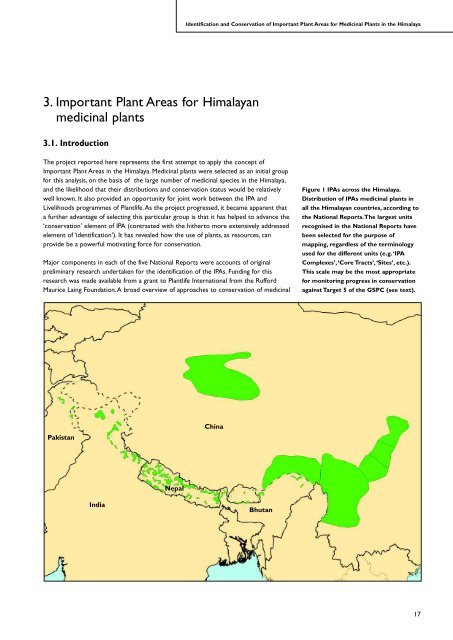<strong>Identification</strong> <strong>and</strong> <strong>Conservation</strong> <strong>of</strong> <strong>Important</strong> <strong>Plant</strong> <strong>Areas</strong> for Medicinal <strong>Plant</strong>s in the HimalayaLake Phoksundo near Rigmo, Dolpawithin the Karnali IPA complex.PHOTO ALAN HAMILTON● The Asia Network for Sustainable Agriculture <strong>and</strong> Bioresources (ANSAB)has been active since 1992 following an enterprise-oriented approach to theconservation <strong>of</strong> medicinal plants. It has experience in developing village-basedmanagement systems for sustainable wild harvesting.● Dabur Nepal is a part <strong>of</strong> an international company that, in Nepal, is involved in thedomestication <strong>of</strong> medicinal plants for commercial cultivation.The company has a largenursery for medicinal plants near Kathm<strong>and</strong>u <strong>and</strong> outreach activities withcommunities.● ESON has established a community-based conservation project on medicinal plantsat Rasuwa near Langtang National Park, funded by an Allachy Award from <strong>Plant</strong>lifeInternational.● The Herbs <strong>and</strong> NTFP Coordination Committee, Department <strong>of</strong> <strong>Plant</strong>Resources (HNCC/DPR) is responsible for national policy on the conservation <strong>of</strong>medicinal plants <strong>and</strong> other non-timber forest products in Nepal.● The International Centre for Integrated Mountain Development (ICIMOD),with its headquarters in Kathm<strong>and</strong>u, is concerned with community development <strong>and</strong>conservation in the Himalayas, sometimes involving medicinal plants. It hosts theMedicinal <strong>and</strong> Aromatic <strong>Plant</strong>s Programme in Asia (MAPPA).● The Institute <strong>of</strong> Agriculture <strong>and</strong> Animal Science (Rampur, Chitwan) runs 3courses on medicinal plants <strong>and</strong> is involved in several related research <strong>and</strong>developmental activities.● Tribhuvan University is undertaking research on several aspects <strong>of</strong> medicinalplants, including compiling a database on medicinal plants in collaboration with ESON.● The World <strong>Conservation</strong> Union (IUCN) is working with communities in severalparts <strong>of</strong> Nepal to raise conservation awareness, <strong>and</strong> to test <strong>and</strong> refine models forcommunity conservation <strong>and</strong> sustainable use <strong>of</strong> non-timber forest products (NTFPs, acategory that includes medicinal plants).Pakistan. Four papers were submitted as contributions to the National Report forPakistan 42-45 . One is the main IPA report, which recommends an integrated approach toconservation, based on these elements: (1) development <strong>of</strong> local institutions to managemedicinal plants on communal l<strong>and</strong>; (2) introduction <strong>of</strong> rotational grazing <strong>and</strong> rotationalharvesting, based on divisions <strong>of</strong> valleys into blocks for use at different times (plus use <strong>of</strong>quotas for critical species); (3) promotion <strong>of</strong> cultivation on private l<strong>and</strong> (to take thepressure <strong>of</strong>f wild collection); (4) engagement <strong>of</strong> local communities in appropriate ways,based on raised awareness <strong>and</strong> an equitable sharing <strong>of</strong> benefits (e.g. to encourage thecollection <strong>of</strong> medicinal plants at the right times <strong>and</strong> in the right ways); (5) determination<strong>of</strong> the best times for collection <strong>of</strong> particular species, based on knowledge <strong>of</strong> theirregeneration features <strong>and</strong> presence <strong>of</strong> active compounds; (6) provision <strong>of</strong> improvedmarket information for collectors; <strong>and</strong> (7) basic field trials <strong>and</strong> demonstration plots. One<strong>of</strong> the other reports, on Baluchistan, describes a survey which revealed the manychallenges facing development <strong>of</strong> the medicinal plant sector in the Suleiman Range.Collection <strong>of</strong> medicinal plants for sale is undertaken on a casual basis mostly by women<strong>and</strong> children, with very low prices paid to the collectors.The other two reports are onSwat, a district lying in the North West Frontier Province <strong>of</strong> Pakistan. One describes theresults <strong>of</strong> some cultivation trials. Overall, cultivation only proved successful for 2 <strong>of</strong> the6 species tried (Valeriana jatamansi,Viola serpens), demonstrating the hazards <strong>of</strong>promoting village cultivation <strong>of</strong> medicinal plants without prior research.The other Swatreport outlines a plan for the sustainable production <strong>of</strong> medicinal <strong>and</strong> economic plantsin Kalam.This report describes field studies on the availability <strong>of</strong> 25 selected species,with estimates <strong>of</strong> harvesting rates as required for sustainable wild collection.16
<strong>Identification</strong> <strong>and</strong> <strong>Conservation</strong> <strong>of</strong> <strong>Important</strong> <strong>Plant</strong> <strong>Areas</strong> for Medicinal <strong>Plant</strong>s in the Himalaya3. <strong>Important</strong> <strong>Plant</strong> <strong>Areas</strong> for Himalayanmedicinal plants3.1. IntroductionThe project reported here represents the first attempt to apply the concept <strong>of</strong><strong>Important</strong> <strong>Plant</strong> <strong>Areas</strong> in the Himalaya. Medicinal plants were selected as an initial groupfor this analysis, on the basis <strong>of</strong> the large number <strong>of</strong> medicinal species in the Himalaya,<strong>and</strong> the likelihood that their distributions <strong>and</strong> conservation status would be relativelywell known. It also provided an opportunity for joint work between the IPA <strong>and</strong>Livelihoods programmes <strong>of</strong> <strong>Plant</strong>life.As the project progressed, it became apparent thata further advantage <strong>of</strong> selecting this particular group is that it has helped to advance the‘conservation’ element <strong>of</strong> IPA (contrasted with the hitherto more extensively addressedelement <strong>of</strong> ‘identification’). It has revealed how the use <strong>of</strong> plants, as resources, canprovide be a powerful motivating force for conservation.Major components in each <strong>of</strong> the five National Reports were accounts <strong>of</strong> originalpreliminary research undertaken for the identification <strong>of</strong> the IPAs. Funding for thisresearch was made available from a grant to <strong>Plant</strong>life International from the RuffordMaurice Laing Foundation.A broad overview <strong>of</strong> approaches to conservation <strong>of</strong> medicinalFigure 1 IPAs across the Himalaya.Distribution <strong>of</strong> IPAs medicinal plants inall the Himalayan countries, according tothe National Reports.The largest unitsrecognised in the National Reports havebeen selected for the purpose <strong>of</strong>mapping, regardless <strong>of</strong> the terminologyused for the different units (e.g.‘IPAComplexes’,‘Core Tracts’,‘Sites’, etc.).This scale may be the most appropriatefor monitoring progress in conservationagainst Target 5 <strong>of</strong> the GSPC (see text).PakistanChinaNepalIndiaBhutan17
















